
|
Sale 12
Manuscript and Collectibles Auction
| Lot |
Photo |
Description |
Realized |
Lot 677 |
 |
A Handsome Gangetic Valley Harpoon of Medium Size. Ancient India, Uttar Pradesh, c. 1500-1200 BC. Harpoon of copper, with reinforced triangular blade of medium width on thick cylindrical shaft -- this tapering towards a narrower flattened base. The ends of the heavy blade terminate in longish barbs, with additional backwards-facing barbs symmetrically arranged along the shaft. Piercing at rear most barb for attaching head to handle. A very well preserved example of these scarce tools or weapons, with very fine two-tone green patina. Length: 12-7/8".
Estimated Value $400-UP.
Ex Gangetic "Hoard," sold Sotheby's NY, 9-20/21-85, lot 334. Small hoards of copper objects of this type have been found for the most part in Uttar Pradesh, with additional finds from sites in Bihar and Madhya Pradesh, plus finds to the west in Pakistan, e.g. Shalozan, along with findspots further south in Bhagrapir, in Orissa, and at Kallur. This and the following two lots are from the Sotheby group cited. According to Agrawal, harpoons of this type "could have been used for killing fish or big game, as shown in a rock-shelter in Mirzapur"; for type and discussion, cf. pp. 204-207.
View details and enlarged photo
| Unsold |
Lot 678 |
 |
A Large and Imposing Gangetic Valley "Antenna Sword." Ancient India, Uttar Pradesh, c. 1500-1200 BC. Sword of cast and wrought copper. The narrow triangular blade having a sharply carinated reinforcing central rib and thickend tip, strengthened for piercing. The blade ends terminating in rounded barbs. The sword's tang of flattened rectangular section, a thick sliver of which has been peeled back to form a very sharp, rounded barb. It is this feature which earns this class of weapon its nickname. A few minor dents along the blade, otherwise with good green patina under cleanable encrustations. Pleasing example, and not often seen. Length: 19-1/8".
Estimated Value $350-UP.
Ex Gangetic "Hoard," sold Sotheby's NY, 9-20/21-85, lot 334.
View details and enlarged photo
| Unsold |
Lot 679 |
 |
Lot of Two Bronze Blades -- A Robust Persian Spearhead, and a Slim Indian Harpoon. Luristan, N.W. Iran, & Ancient India, Uttar Pradesh, c. 1500-1200 BC. The two an interesting contrast of blade types. The Indian harpoon of the type seen in the earlier lot, but slimmer and smaller, and comprised of a multi-barbed blade only. This with six paired, symmetrical barbs (one missing where blade was pierced for attaching cord). Behind these, two thick, triangular swellings, one with an additional piercing to take a second cord. The Persian point, c. 1000-800 BC., is comprised of a narrow lanceolate blade, with wide, rounded midrib, and set on a broad and very thick, squarish shaft with flaring protrusions and sharply tapered tang. Blade edges well sharpened. The Indian piece a little bent, but shows overall fairly modest use; with pleasing medium to tan green patina. The Persian Very Fine, with moderate signs of use, and with deep green to dark brown patina. Length of harpoon: 9-3/4". Length of spear point: 14-1/2"; comes with black metal stand. Lot of 2 pieces.
Estimated Value $300-UP.
Harpoon, Ex Gangetic "Hoard," sold Sotheby's NY, 9-20/21-85, lot 334. Good dealer lot.
View details and enlarged photo
| Unsold |
Lot 680 |
 |
An Important Dagger, with Royal Inscription. Western Iran, Luristan, c. 1200-1000 BC. Bronze dagger, cast and wrought, of usual form. The blade somewhat lanceolate, with heavy midrib, and long, unworked "throat." The tapered handled, with crescentic pommel, and channeled to accept inlays. These would have been in bone, ivory, or stone, and were held in place by the folded over flaps at the handle's base (only one extant). Inscribed on each side at blade's throat, are two registers of cuneiform inscription. Also, on one side a bisected arch, and an outlined cross on the other. This dagger a well used tool. The blade shows repeated sharpening and some nicks, while two of the handle flaps have worn thin until they fell off. Dagger with good dark green and black patina. Length: 12". Very rare!
Estimated Value $2,000 - 2,500.
Typically, inscribed Luristan daggers would bear the name of the king who would have given the weapon as a gift to a soldier or a member of his private bodyguard. The cross seen on this blade is ethnic emblem typical of Kassite inscriptions and art -- perhaps indicating this blade saw its gifting further west, among the Kassite kingdoms.
View details and enlarged photo
| Unsold |
Lot 681 |
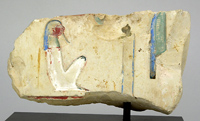 |
A Superb, Painted Egyptian Wall Fragment. Egypt, Dynast XIX - XX, 1320-1085 BC. Carved in a fine grain creme-colored limestone, an image of a seated god, facing right, is carefully and crisply modeled in sunk relief. Probably part of a larger register of hieroglyphs, a linear border, and a reed leaf can be seen to the right. The god's face painted in red ochre, his wig and beard, along with a broad collar are in two shades of blue. The leaf likewise shows a vivid cerulean blue, and a more subdued greenish blue. The surface of the limestone superb, the paint original and in an exceptional state of preservation. Size: 4-3/8 x 7-1/2". On a custom bronze stand. A splendid work of art! If one were to own but a single example of Egyptian wall art, for its simplicity, directness and preservation, this one should merit your attention.
Estimated Value $3,000 - 4,000.
The larger scale of these hieroglyphs indicate that this fragment of text likely came from a royal tomb relief, possibly the royal Theban tombs.
View details and enlarged photo
| Unsold |
Lot 682 |
 |
Bronze Statuette of an Egyptian Priest. Egypt, Late Dynastic Period, c. 750-350 BC. The priest in a striding pose, wears a long, close fitting skirt and a skull cap, and stands on a rectangular base. He holds one hand out before him, while the other supports close to his chest an image of a seated cynocephalus baboon -- indicating his likely being a priest of Thoth. The baboon rests its paws on its knees and appears to be wearing an Apis-Uraeus crown. Sculpture with pleasing, variegated deep olive, brown, and red patina. Height: 3". An interesting work, showing a more human aspect to Egypt's sometimes bewildering multitude of gods and beings.
Estimated Value $2,500 - 3,000.
Ex. Swiss private collection.
View details and enlarged photo
| Realized
$2,300 |
Lot 683 |
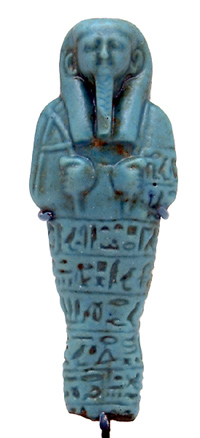 |
Small Fragmentary Ushabti with Choice Deep Turquoise Glaze. Egypt, early Dynasty XXVI, c. 664-550 BC. Ushabti of the "Grand Overseer, Pa-di-Hor-Resnet." Fashioned in a deep turquoise-glazed faience, the ushabti of mummiform shape. Figure stands with arms crossed, holding a hoe and a seed sack (thrown over the shoulder). Figure with lappet wig, beard on chin, and swathed in Osirid-like garments. Eight panels of hieroglyphic inscriptions run horizontally along front and back. Ushabti with good detail and pleasing features, the hieroglyphs clean and very legible. Piece finely preserved. Height: 3", on black-colored base. A colorful object which, even for its small size, has a certain monumental air.
Estimated Value $2,000 - 2,500.
Ex. Christos Bastis Collection; Sothebys NY (12-9-99), lot 34.
View details and enlarged photo
| Realized
$2,300 |
Lot 684 |
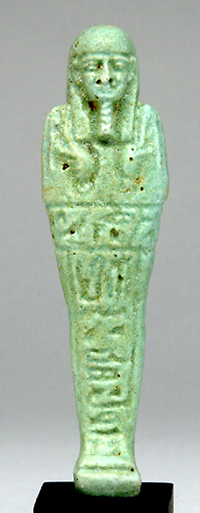 |
Colorfully Glazed Faience Ushabti. Egypt, Late Dynastic Period, Dynasty XXVII or later, c. 525-350 BC. Fashioned in a light turquoise-green glazed faience, the ushabti of mummiform shape. Figure stands with arms crossed, holding adze and hoe. Figure with lappet wig, beard on chin, and swathed in Osirid-like garments. Inscriptions down the front of the figure in two panels: one horizontally under the arms, and one vertical along the legs. Figure sharply molded, with good detail and pleasant features. Intact and finely preserved. Height: 4-3/8", on black-colored base. An excellent example of this popular Egyptian antiquity, with much eye appeal.
Estimated Value $500 - 700.
View details and enlarged photo
| Unsold |
Lot 685 |
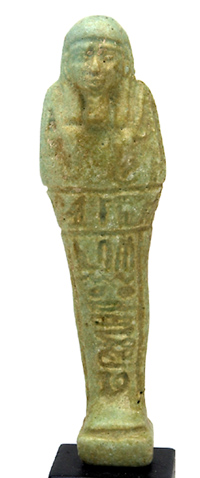 |
Nicely Glazed Faience Ushabti. Egypt, Late Dynastic Period, Dynasty XXVII or later, c. 525-350 BC. Fashioned in a light green to olive-glazed faience, the ushabti of mummiform shape. Figure stands with arms crossed, holding adze and hoe. Figure with lappet wig, beard on chin, and swathed in Osirid-like garments. Inscriptions down the front of the figure in two panels: one horizontally under the arms, and one vertical along the legs. Ushabti with good detail and bold features, the hieroglyphs clean and very legible. Intact and finely preserved. Height: 4-1/2", on black-colored base. Another choice example of this popular Egyptian antiquity.
Estimated Value $500 - 700.
View details and enlarged photo
| Unsold |
Lot 686 |
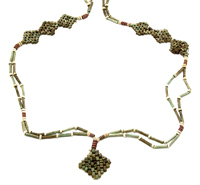 |
Stylish Necklace Comprised of Ancient Faience Beads. Egypt, Saite or Late Period, c. 600-300 BC. The necklace a reconstruction in Pharaonic style, consisting of short lengths of double strands of blue-green tubes alternating with white discs. The double strands bordered by paired red and white discs. Comprising the necklace's pendant and two ornamental side panels are lonzenge-shaped constructions of joined blue-green to olive colored double discs (these scarcer beads are twice pierced bead and look like the number 8 in section). Beads generally very fine or better, a few chipped or cracked. Length: 46". Stylish, and something different to the usual "Queen Nefertiti" necklace concoctions.
Estimated Value $250-UP.
View details and enlarged photo
| Realized
$150 |
Lot 687 |
 |
A Fabulous, Geniune Egyptian Mummy (mummified fish)!! Egypt, Late Period, c. 500-350 BC. The fish with broad, flattish head and long, slim body, and single dorsal fin. The species most likely that of the barbus lepidotus, a freshwater species which was sacred to the goddess, Mehyt. The mummy with under wrappings of fine texture linen, a layer of papyrus(?) cording, and a final, outer layer of coarse textured linen. The latter with head and eye details in dark brown ink. At the rear, the tail is folded back against the body. The wrappings are virtually complete, with a few tatters here and there. We haven't x-rayed this, but there could even be amulets attached to the fish within the layers of inner wrappings. This is one of the best, and most complete examples that we've seen in some time. We recommend your perusal and active participation on this one. It's not likely you'll happen across a better specimen in the near future. Length: 18". In custom plexiglass case.
Estimated Value $750-UP.
Mehyt was a local lion-headed goddess for the Abydos area. While her attributes remain somewhat uncertain, the fact that this abundantly represented species of fish was dedicated to her, shows that she was a deity of some standing in what was one of ancient Egypt's most important regions.
View details and enlarged photo
| Realized
$443 |
Lot 688 |
|
Withdrawn
| Unsold |
Lot 689 |
|
Withdrawn
| Unsold |
Lot 690 |
|
Withdrawn
| Unsold |
Lot 691 |
|
Withdrawn
| Unsold |
Lot 692 |
 |
Vintage Views of Ancient Egypt, by Antonio Beato. Egypt, c. 1880's. A lot of 5 sepia-toned albumen prints, each mounted on black-faced board, each with a somewhat later paper label at bottom. These ancient contact prints are carefully composed, handsomely crafted, and filled with an immense wealth of detail. In this group are such notable monuments as: A god and hieroglyph encrusted wall at Karnak, detailing the genealogy of Ramses the Great; a similar wall of a shrine at Denderah depicting Cleopatra in her traditional Egyptian form; a row of ram-headed sphinxes at Karnak; the massive pillars from the hypostyle temple at Philae, with differing papyrus and lotiform capitals; and lastly, the fabulous obelisk of Ramses the Great at Luxor. Most of the photos signed "A Beato" on the negative. Photos generally very fine. All are old deaccessions from a northern California public library. Image size: c. 10-1/4 x 8-1/8". These are choice archives of sites that are now quite often much altered, damaged, or even lost. Lot of 5 pieces. Often selling for $50-150 each, Beato's Egyptian photos are much sought after by cogniscenti and collectors. Worthy of spirited bidding.
Estimated Value $175 - 300.
Antonio Beato (c. 1810 - c. 1930) and his brother, Felicio, were among the more notable scenic photographers of exotic and foreign vistas during the nineteenth century. Felicio, perhaps the more famous of the two, made a considerable name for himself with his albums and photo essays of Japan at the end of the Shogun era, and with extensive, sometimes controversial coverage of India. Antonio (or, Antoine), meanwhile, stayed in Egypt and ran a flourishing business taking pictures of the antiquities there.
View details and enlarged photo
| Realized
$259 |
Lot 693 |
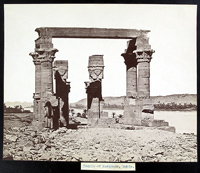 |
Vintage Lot of Five Beato Views of Ancient Egypt. These prints are as those in previous lot. Here we see: The temple at Kardosse, Nubia, with the startling Hathor-head capitals; a splendid relief at Komombos showing Horus receiving Ptolemy V and his queen, Cleopatra I; a great, historical view of the Sphinx and pyramids at Giza, still deeply covered in sand; an interesting scene with a pharaoh and kneeling queen in a boat, facing a god, all of their faces purposefully obliterated in antiquity; and lastly, an interior shot of the tomb of Seti I(?), with ram-headed Khnum in a shrine, carried by boat, which is enveloped by a huge snake. Lot of 5 pieces. This a very good group indeed!
Estimated Value $175 - 300.
View details and enlarged photo
| Realized
$288 |
Lot 694 |
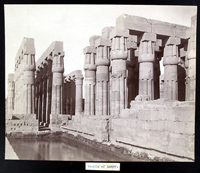 |
Vintage Views of Egyptian Temples, A Final Group of Beato's Photographs. This batch like the preceding two lots, again, from the northern California library deaccession. Here: two views of the impressive temple complex at Luxor; the marvelous reliefs on the exterior of the Temple of Hathor, at Dendera; a view of the massive pillars at Medinet Habu, with 19th century Egyptians for scale; and last, the delightful, delicate shrine, "Pharaoh's Bed," on the island of Phile. Again, an excellent group, and all finely preserved. Lot of 5 items.
Estimated Value $175 - 275.
View details and enlarged photo
| Realized
$259 |
Lot 695 |
 |
A Fine and Complete Tile with the Tenth Legion Stamp, from Ancient Jerusalem. Israel, late 1st - 2nd century AD. The tile, a paver, is fashioned from a gritty pinkish-orange clay and hard-fired. A square of 7" on each side, and about 1-1/2" thick,the tile has impressed on its face a rectangular stamp with the letters, "LEG X FR." This stands for "Legio Decima Fretensis." Modest chip on back at one corner, otherwise the tile face clean and choice. The letters clearly and deeply impressed on this tile, making it a much superior and desirable example. An important artifact for the Judaica or military collector.
Estimated Value $750 - 1,000.
Actually found in Jerusalem, the owner of this and the following lot is the same consignor who offered three similar specimens in our previous antiquities offering. These are the last of his tiles that we were able to get. Don't miss your chance to acquire a piece (literally speaking of course!) of historic, ancient Jerusalem.
Stationed in Palestine and Syria, the Tenth Legion made up the forces that Vespasian employed in northern Israel during his campaign of 66 AD. Later, the legion comprised a good portion of the troops that destroyed Jerusalem under Titus. Three years later they completed the mopping up of the First Revolt when they captured Masada. Afterwards, the Tenth Legion became the official permanent garrison for the province of Judaea. Following the Bar Kochba revolt, the legion was stationed in Jerusalem (which was renamed Aelia Capitolina by Hadrian) itself. In the early 1990's a major Tenth Legion site was discovered during excavations for a parking lot next to the National Auditorium in Jerusalem. At that time a number of like tiles came on to the market, but these have long since been dispersed. See: N. Avigad, Discovering Jerusalem, 1980, p. 206, figs. 2, 3, and 4.
View details and enlarged photo
| Realized
$834 |
Lot 696 |
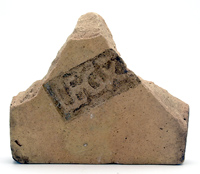 |
A Sizable Tile Fragment with the Tenth Legion Stamp. Israel, Jerusalem, late 1st - 2nd century AD. The tile, a paver, like the previous example, is fashioned from a gritty orange-tan clay and hard-fired. Again, a square of 7" on each side, and about 1-1/2" thick. Here about two thirds of the tile present. Of the legionary stamp, "LEG X" remains. The impression bold, and the letters stand out clear. The tile face clean and with little wear. On the back a thick layer of the mortar still adheres; this, interestingly shows the use of crushed shell as filler. A fine example, and very affordable. Size: 7" x 6".
Estimated Value $400 - 500.
View details and enlarged photo
| Unsold |
Lot 697 |
 |
Another Choice Tile Fragment of the Tenth Legion. Israel, Jerusalem, late 1st - 2nd century AD. The tile, another paver, is a little different from the previous examples. The clay is a little finer grain, and a deep pink color. This one a square of about 7-1/4" on each side, and about 1-1/4" thick. Here about half of the tile present, with three quarters of the legionnary stamp remaining: "…E X FR". This stamp with a shortened inscription, and in a smaller, more delicate style. The extant impression bold, the letters very clear. The tile face clean and with only minor wear. Small collection number inked on the side. Again, a fine example, and very affordable. Size: 7-1/4" x 4-3/4".
Estimated Value $400 - 500.
View details and enlarged photo
| Unsold |
Lot 698 |
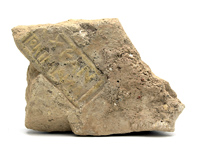 |
A Final Tile Fragment of the Tenth Legion. A Rare, Published Example from Aelia Capitolina. Israel, Jerusalem, reign of Elagabalus, 218-222 AD. The fragment a very thick tile, in a coarsely mixed dark pink clay, covered with whitish patina. The legionnary stamp with line border, the inscription: "LXF ANTONIAIA," in two lines. Impression bold, the letters very clear, but the lettering appears to have been cut by one who was ill at ease with Latin script. The tile face clean with some minor adhering mortar or concretion. Size: 7-1/4" x 4-3/4". Rare!
Estimated Value $1,500 - 2,000.
Published: Ya'akov Meshorer, The Coinage of Aelia Capitolina, Jerusalem 1989, p. 63 (illustrated), where he points out that use of the title, Antoniniana, appears to be limited to the time of Elagabalus -- it specifically appearing on his coins issued at Aelia Capitolina. Thus the tile originates in the construction or repairs going on in Jerusalem during his reign.
View details and enlarged photo
| Unsold |
Lot 699 |
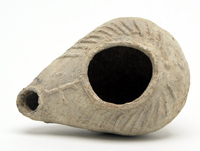 |
A Fine and Pristine Early Christian Oil Lamp. Palestine, c. 5th-7th century AD. Molded of a fine-grain, deep red to red-orange ware, with thin creme slip, the lamp drop- or "slipper"-shaped, with wide fill hole, narrow nozzle, and simple ring foot at base. Along the shoulders, encircling the fill hole, a raised stylized wreath motif. Just behind nozzle, a Greek cross with equidistant arms and serif ends. Lamp in choice condition, with slight evidence of soot stains at nozzle. Length: 3-5/8".
Estimated Value $200 - 300.
This and the following two lots are especially select examples of these popular early Christian antiquities. Their moldings are sharp and, opposed to what is generally encountered these days, their signs of use or wear minimal.
View details and enlarged photo
| Realized
$253 |
Lot 700 |
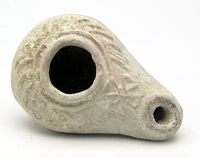 |
Another Fine Oil Lamp with Cross Emblem. Palestine, c. 5th-7th century AD. Lamp closely similar to previous lot, but heavier and more robust, and with white slip. Encircling shoulders, stylized wreath or fillet, along with ring bordering nozzle. Behind nozzle, a cross patee with triangular arms. Lamp in choice condition, with faint soot traces at nozzle. Length: 4".
Estimated Value $200 - 300.
View details and enlarged photo
| Unsold |
Lot 701 |
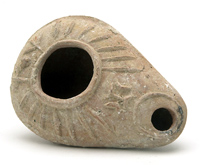 |
And One More Pristine Early Christian Lamp. Palestine, c. 5th-7th century AD. Lamp as previous lot, but showing only the thinnest of slips. Again, stylized wreath or fillet, along with ring bordering nozzle. Behind nozzle, a Greek cross with very large serif ends. Lamp sharp and choice, with slight soot traces. Length: 3-3/8".
Estimated Value $200 - 300.
View details and enlarged photo
| Unsold |
Lot 702 |
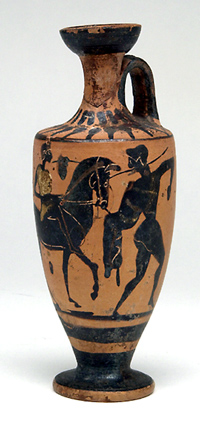 |
Attic Black-figured Lekythos with Revelers. Athens, c. early 5th century BC. Vessel of usual shape: footed, of narrow conical form with carinated shoulders, constricted neck, single handle, and funnel mouth. Lekythos with painted figures in black on red ground, with added details incised, or in white paint. Scene: youth in short tunic on walking horse right. Two nude reveling youths flank rider on either side. Vine and grapes in background. Black darts around shoulders and neck, along with handle, rim and foot in black. Repair at neck, otherwise very well preserved for these, which are often very weathered or eroded. Height: 5-1/2".
Estimated Value $1,000 - 1,500.
Ex Summa Galleries; ex Milton Anastos Collection.
View details and enlarged photo
| Realized
$1,150 |
Lot 703 |
 |
Attic Black-figured Lekythos with Chariot Race Scene. Athens, c. early 5th century BC. Vessel shape similar to previous, but higher and more cylindrical, with tubular mouth, and thick stepped foot. Lekythos with painted figures in black on red ground, and added details in white and red paint, with considerable incised work. The scene shows two quadrigae (with black and white horses) passing a ribbon entwined terminus or post -- the two drivers arched forward in excitement. Usual black darts around shoulders. Chipping to mouth, with repairs to neck and handle. Otherwise, paint very well preserved, the black glaze extremely glossy. Height: 5-1/2". Explicit sports scenes are less common, and so always desirable. This example, albeit simply rendered, displays much vivacity.
Estimated Value $1,000 - 1,500.
Workshop of the Emporium Painter. Cf. C.H.E. Haspels, Attic Black-Figured Lekythoi, Paris 1936, pl. 48, no. 5. His lekythoi, however, are normally white ground, and so this example may be from the hand of a workshop associate. Also cf. CVA Cambridge I, pl. 22, no. 39, also with a chariot race.
View details and enlarged photo
| Unsold |
Lot 704 |
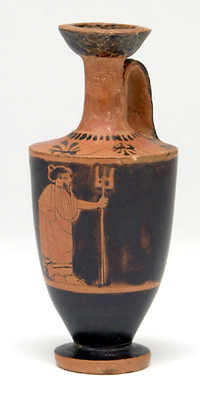 |
A Fine Miniature Red-figured Lekythos showing Poseidon. Athens, c. mid 5th century BC. Vessel of normal shape, finely potted and with choice glossy glaze. The body all in black but for the single figure of bearded Poseidon, clad in chiton and overmantel, standing right and holding trident. At vessel's neck a row of darts, with a vine of palmettes below. Repairs to mouth and upper neck; rest of bottle pristine and choice. Height: 3-3/4". A delightful little miniature. The rendering a lively characterization. Sophisticated miniatures like this are scarce, not to mention that Poseidon is not particularly widespread in the pictorial repertoire.
Estimated Value $1,500 - 2,000.
View details and enlarged photo
| Unsold |
Lot 705 |
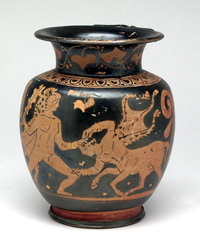 |
A Large Red Figure Mug Depicting Herakles. Magna Graecia, Apulia (or perhaps Paestum), c. 350-330 BC. An unusually large and finely potted "mug" (type VIII mug) is executed in both painted and incised technique. The glaze is a silvery metallic-looking black, with added details in yellow. The primary scene with Herakles, clad in the skin of the Nemean lion, who raises his club to slay the centaur Nessos, whom he grasps by the hair. Nessos with panther skin draped over his shoulders. In yellow paint is a wreath and bracelets for Nessos, and bracelets and anklets(!) for Herakles. Fillers in field comprised of large tendrils and acanthus palmette. At mug's shoulder a row of ovolo and petals. At neck, incised ivy vine, the leaves painted. A nearly invisisble repair at handle, otherwise vessel intact, and very well preserved (some trivial rubbing or flaking to glaze). Height: 5-1/2".A notable lot for both the rare, large size of the mug, plus the rarity of Herakles scenes in this body of work.
Estimated Value $3,500 - 4,000.
Vessel attributed to the Lampas painter. Cf. Bottini & Fresa, Forentum II, Venosa 1991, pl. 51.
Nessos was a centaur who, ultimately, was the instrument of Herakles' death. Nessos carried Deïanira, the daughter of King Oenus (along with being Herakles' wife), across the River Evenus and then tried to rape her while Herakles was stranded on the other bank. Herakles saved her by shooting him with an arrow that had been dipped in the poison of the Lernaean hydra. The dying Nessus told the gullible Deïanira to gather up some of his blood to use as a love potion on Herakles, should the hero's love for her ever begin to wane. Later, when Herakles began wooing Iole, Deianira sent to Herakles a robe that had been dipped in Nessus' blood. The centaur's blood actually proved to be a poison which brought about the hero's demise. Deïanira, finding out what she had actually done, commited suicide.
View details and enlarged photo
| Unsold |
Lot 706 |
 |
A Red-figured Lykanis with Intricate Feminine Vignettes. Magna Graecia, Campania, c. 350-320 BC. The lykanis, a twin-handled, lidded dish, is one of the preeminent ceramic forms peculiar to the Italian Greeks. The base in fine black glaze, with a reserve band in red around the rim delineated as a laurel wreath. The elaborate lid with three distinct scenes. Each of the women are attired in similar chiton, headdress, and white shoes. A: Woman seated on rocks and holding mirror; Eros, holding sash, flies toward her from behind. B: Eros, standing at left, offers a seated woman a phiale containing fruit; Eros again holds sash, the woman holds wreath and plucks at garment as if about to remove it (she perhaps Aphrodite?). C: Woman, holding large phiale and wreath, runs to right, her head reverted. Figures drawn in a very lively manner in black, with considerable added details in white and yellow. Numerous floral elements serve as fillers in the field. Knob of lid with addorsed palmettes; wave pattern along bottom rim. Lower dish intact and pristine. Lid recomposed from a few large fragments and with insignificant restoration -- otherwise extremely well preserved. Width: 9-3/8". Height: 5-5/8". This a particularly fine and decorative example of its class.
Estimated Value $3,000-UP.
Cf. A.D. Trendall, The Red-figured Vases of Lucania, Campania, and Sicily, Oxford 1967, pl. 182, no. 3.
View details and enlarged photo
| Unsold |
Lot 707 |
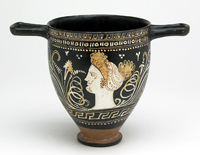 |
A Good Sized and Boldly Painted Skyphos. Magna Graecia, Apulia, c. 350-310 BC. The twin handled cup of slim proportions on small foot. The black glaze fine and even, with slight metallic cast. The ornament consists of applied paint in white and yellow, plus incised line or petal motifs. The front shows the head of a lady of fashion, with richly curled hair held within a sakkos, and flanked by swirling tendrils and leaves. Above, incised and painted petals, ovolo border below. Meander pattern at bottom. The back with alternating rosettes and vine swags; petal border above. Reserve band of red at foot. Recomposed from large fragment, with trivial restoration; otherwise condition especially fine. Height: 4-1/2". Good, careful work for this series. A bold, and flashy antiquity.
Estimated Value $1,000 - 1,500.
View details and enlarged photo
| Unsold |
Lot 708 |
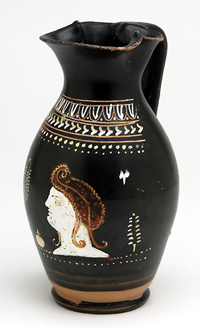 |
Well Crafted Oinochoe with Unusual Portrait. Magna Graecia, Apulia, c. 340-330 BC. This type III oinochoe slimly proportioned and finely potted. The black glaze glossy and very even, with both painted ornament and incised line and petal motifs. The front shows the head of a lady or youth, in white paint, with unusual hair style or headgear of almost Scythian appearance. The head covering red in color and outlined with fine zigzag border in yellow. Curls (or straps) hang to the shoulders. Along central yellow band, faint trace of applied impasto dots, suggesting a wreath. On either side of the head, a pomegranate, a fillet, a plant, and ivy leaves. Above, incised and painted petals, with herringbone pattern underneath. Apparently intact and free of repairs. Aside from slight rubbing at rim, preservation exceptional. Height: 5-1/2". Interesting portrait of good style for this period. Noteworthy and something different.
Estimated Value $2,000 - 2,500.
Cf. M. Bernardini, Vasi dello stile di Gnathia, Bari 1961, pl. 37, no. 2.
View details and enlarged photo
| Unsold |
Lot 709 |
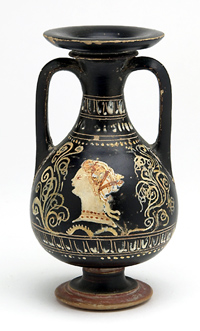 |
An Elaborate Miniature Gnathian Pelike. Magna Graecia, Apulia, c. 330-300 BC. The graceful little ceramic vessel with twin handles, piriform body on short foot, and wide, applicator-like mouth. Over finely fired black glaze, the ornament consists of applied paint in white and yellow, plus incised line or petal motifs. The front shows the head of a lady of fashion, with elaborate coiffure, and flanked by curling vines. Above and below, incised petals highlighted with white.The back with simple rosette and a swag of vine leaves, in white and yellow. Minor wear and nicks to edge of rim, otherwise bottle free of repairs and in choice condition. Height: 4-3/4". Charming late work on a scarce shape.
Estimated Value $1,500-UP.
View details and enlarged photo
| Unsold |
Lot 710 |
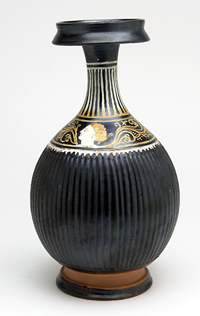 |
An Elegant Gnathia Ware Ribbed Bottle. Magna Graecia, Apulia, c. 330-300 BC. This distinctive bottle finely potted and proportioned. The globular body on broad stepped foot, the narrow neck gracefully curving up the wide mouth with raised and skirted rim. Around the body is neatly crafted vertical ribbing. At the neck and shoulders, in white and yellow paint, the head of a lady of fashion. Emerging on either side of her neck a complex arabesque of tendrils and flowers. Around the vessel's neck, a border of vertical rays. Reserve band of red at foot. Apparently intact and free of repairs. In marvelous condition. Height: 7-3/4". An outstanding example of type. Certainly an eye catching object for any antiquities collection.
Estimated Value $2,500-UP.
Cf. Padget et al., Vase Painting in Italy, Boston 1993, 206-7, no. 132;CVA London I, pl. 8, no. 9.
View details and enlarged photo
| Unsold |
Lot 711 |
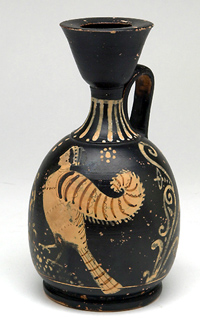 |
A Published Red Figure Lekythos with Rare Siren Motif. Magna Graecia, Paestum, c. 350-330 BC. Squat lekythos type, with broad, almost globular body on flat foot. The strongly constricted neck with wide-rimmed, deep funnel mouth. Small strap handle attaches at back. Main device a siren in profile left, perching on rock from which a plant arises. The siren with painted and incised details. She is flanked on either side by larger tendrils and flowers. Beneath handle, large ornamental acanthus palmette. Intact, and in fine condition. Some minor fading or rubbing to painted tendrils, and some slight flaking in areas of the glaze. Height: 6-1/2". An attractive depiction of this mythological being, who had become rare as a subject on vases at this time.
Estimated Value $1,500 - 2,000.
Published by Trendall, The Red Figured Vases of Paestum, British School at Rome 1987, p. 372, no. 61.
View details and enlarged photo
| Unsold |
Lot 712 |
 |
Stylish Terra Cotta Head of Athena, or Warrior. Magna Graecia, Tarentum, c. 415-375 BC. Molded in a tan-beige ware, with faint greenish cast, the head rather narrow, and from a figure that was more likely meant to be seen from the profile rather than frontally. The head perhaps that of Athena, or a youthful warrior, wearing a Corinthian helmet pushed up high on the head. The head a separate attachment to a complete figure, or possibly a votive object complete in itself. Some slight rubbing at sides and back, otherwise intact and very fine. Height: 3-1/4"; mounted on lucite base.
Estimated Value $1,000 - 1,500.
While the head could well be Athena, its similarity to other votive statuettes from Tarentum make it more likely a heroic male warrior is intended. Sanctuaries excavated in the heart of the city have yielded thousands of votive figurines. Mostly these were dedicated to Dionysus. Much rarer are those statuettes of male warriors. The cloth or leather cap worn beneath the helmet, and visible at the sides and back, derives from the Persian mitra. By the late 5th century, the combination of a mitra and the pushed back Corinthian helmet had come to be a symbol of military prestige, harking back to the Greek victories over the Persians.
View details and enlarged photo
| Unsold |
Lot 713 |
 |
A Charming Spoon in Silver. Roman, 1st-2nd century AD. Derived from earlier Hellenistic prototypes, this example with rod-like, faintly tapering handle, and a shallow circular bowl with a lip or rim. Pointed, decorative finial at end. Spoon well preserved, slightly toned, and showing only moderate wear. Length: 5-1/4". Precious metal dinner utensils are still quite scarce. This pleasing and affordable.
Estimated Value $1,200 - 1,400.
In antiquity, there were two basic spoon forms that were developed for dealing with liquid or semi-liquid foods. The ligula type is akin to our modern table spoon, with the elongated bowl. The second type, seen above, is the cochlear, wherein the bowl is circular, and somewhat small. It is so named because its use was associated with the eating of shellfish (mollusks), coclea in Latin: "a snail." The end of this class of spoons is often rounded or articulated, in order to help push the food out of the shell.
View details and enlarged photo
| Unsold |
Lot 714 |
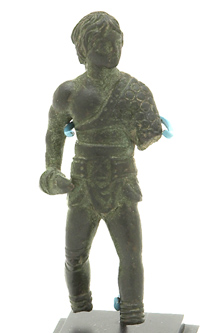 |
A Splendid Little Bronze Figure of a Gladiator. Roman, c. 2nd - early 3rd century AD. The youthful "entertainer" modeled with a lithe, yet muscular body, while his hair is in longish coarse locks, of a style seen in both Antonine and early Severan portraits. His armor consists of scaled mail strapped over one arm and shoulder, a short Thracian sword, leather padding and a broad armored belt at the waist, a single greave and knee padding on one leg, and heavy leather strapping at the ankles. His class of gladiator was known as a retarius. Losses at feet and one arm, otherwise bronze quite pristine, with choice, smooth dark green to black patina. Height: 2-3/4". A truly fine characterization.
Estimated Value $2,500-UP.
The popularity of certain gladiators in Roman times, was in some ways comparable to the adulation we accord sports figures in our times. Yet even back then, while the "sport" satisfied a particular blood lust demanded by the public, gladiators still were never quite respectable. Even as a sort of celebrity, they retained about them an aura of the scandalous and distasteful. Nevertheless, they held considerable fascination with the Roman sporting public. This is evidenced by the number of models and renderings (in a wide variety of media) of most of the types of gladiators that have come down to us. The above example is certainly as fine an example as one will see in the market today. This one, in fact, may well have had a separately fashioned helmet that would have dropped over his head -- rather like the action figures, with separate accessories, that one sees in toy stores today. Again, examples of such are known in bronze and terra cotta.
View details and enlarged photo
| Unsold |
Lot 715 |
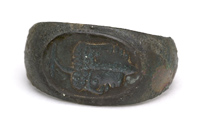 |
Attractive Roman Bronze Ring, with Amuletic Intaglio. Roman Thrace, 2nd century AD. Ring like that of previous lot in form -- with broad, rounded shoulders and slightly raised integral "gem" at center. Device: a grape cluster formed from two addorsed masks or faces. One older, and one younger -- perhaps likenesses of Dionysus and a satyr. Their hair and beard are represented by rows of circular drillings which serve to emphasize the texture of the individual grapes. Intact and finely preserved, with dark green to brown patina. Width: 7/8". Stylish and wearable! Again, a superior example of its class.
Estimated Value $400 - 450.
The ancient Romans, as commented upon by contemporary writers, were a notoriously superstitious lot. Thus the their abundant use of charms and magical amulets. The above ring was part of large class of gems and jewelry of this sort -- a class which very much increased as the Roman Empire moved into its later years and decline. The device, by combing different elements into another, wholly different object, had the magical effect of confusing "bad luck" (or the "evil eye", if you will), and thus preventing it from adhering or attaching itself to the ring's wearer. The types of subjects represented, and various combinations they were employed in, are legion. It is this intriguing variety that makes these among the more popular of Roman "engraved gem" collectibles.
View details and enlarged photo
| Realized
$489 |
Lot 716 |
 |
Choice Roman Bronze Ring, Engraved with Dionsiac Motif. Roman Thrace, 2nd century AD. Fashioned from brass or orichalcum, the bezel with chased border around intaglio to mimic the effect of it being gem-set. Device: a very well engraved head or mask of a satyr (or youthful Pan), in profile and regarding a full grape cluster. A little rubbing on the edges and back, otherwise ring finely preserved, which choice dark green patina. Width: 7/8". A superior example of its class, and still wearable.
Estimated Value $400 - 450.
Rome was a class divided society. From early on various sumptuary laws were passed which restricted in detail what levels of classes were allowed to own and wear gold. Thus in the early Empire the large quantities of rings and jewelry in bronze, or even iron. The above ring's owner likely belonged to one of the restricted groups. The ring, when fresh and new, would have very much looked like the gold that its possessor may have been barred from wearing.
View details and enlarged photo
| Unsold |
Lot 717 |
 |
Small Bronze Ring with Male Portrait. Roman Provinces, late 2nd - 3rd century AD. The ring shape evolved from that of the previous two lots: the shoulders now thicker and wing-like, with the juncture of the top and sides becoming beveled. Device: draped bust of man, the head in profile. Head with thickly curled hair and beard. Portrait stylized, and could represent either a private or imperial individual. Intact, with minimal wear. The patina a fine dark green, with some earthen areas. Width: 7/8". Solid and wearable.
Estimated Value $300 - 400.
View details and enlarged photo
| Unsold |
Lot 718 |
 |
A Fine Ribbed Bowl in Aqua-colored Glass. Greco-Roman, 1st century AD. The mold-made bowl cast, of shallow phiale-like form, with concave base and twenty-four radiating ribs around the bottom. As is usual for this class, the exterior with smooth fire polish while the rim and interior show lapidary polishing techniques, along with three wheel-cut grooves as ornament within. Some light, cleanable calcerous patina along the sides, and slight traces of iridescence. Piece intact and perfect -- and without any of the occasional age cracks that these heavy glass bowls seem to accumulate. Diameter: 5-1/4". A choice glass antiquity!
Estimated Value $2,500-UP.
Cf. Oppenlander Coll., no. 254.
View details and enlarged photo
| Unsold |
Lot 719 |
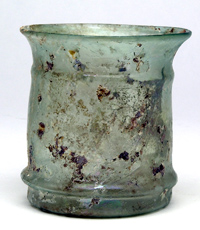 |
Ancient Roman Glass. A Handsome and Robust Cup, or Beaker. Eastern Mediterranean, c. 1st-2nd century AD. Crafted in fairly thick, light green glass, the cup slightly barrel-shaped with two decorative (and strengthening) encircling ribs at top and bottom. The ribbing created by vertically compressing the hot glass of the cylindrical body and creating an outward fold. At the top, the mouth is wide and funnel-like. Intact with transparent to slightly crusty silvery to red and green iridescence, along with some cleanable dirt. Height: 3-1/4". The cup quite symmetrical, and thus a very pleasing example of this shape.
Estimated Value $200 - 275.
View details and enlarged photo
| Realized
$328 |
Lot 720 |
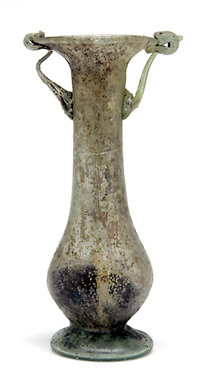 |
Ancient Roman Glass. Delicate Footed Vial with Twin Handles. Eastern Mediterranean, c. 2nd century AD. The unguentarium in light green glass, with twin trailed handles of the same color. The vessel a slim tube with small ovoid body atop integral folded foot, and wide funnel-like mouth at the top. Bottle with discreet repairs at several places, otherwise in fine condition with delicate, mostly silvery iridescence. A handsome example of type, well proportioned, and symmetrically crafted. Within the body is a ball of a hard black and earthen substance. This could well be the remains of the precious oil or lotion that once filled this artful object, which was destined for the lady's boudoir. Height: 4-1/2".
Estimated Value $175 - 225.
View details and enlarged photo
| Realized
$138 |
Lot 721 |
 |
Ancient Roman Glass. Fancy Mold-blown Flask with Wide single Handle. Eastern Mediterranean, c. 2nd-3rd century AD. In light green glass, this decorative flask with dome-like body with shallow vertical ribbing, highly concave base, short cylindrical neck, and flat everted lip with folded "throat" beneath. The separately applied handle, ornately folded and with "combed" ribbing, is of the same color as the bottle. Some modest chipping to the edge of the handle, plus some repair to the base of the neck, otherwise the bottle in fine condition with delicate, transparent silvery to red and green iridescence. Height: 3-5/8".
Estimated Value $175 - 275.
View details and enlarged photo
| Realized
$213 |
Lot 722 |
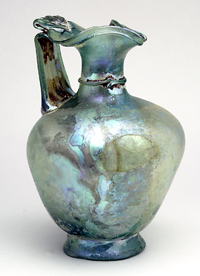 |
An Impressive Large Pitcher in Green Glass. Roman, 2nd-3rd century AD. The pitcher free blown, with the body of broad, swelling drop shape, which rests on high foot created by folding the base inward. The vessel's neck fairly narrow while the mouth, wide and funnel-like, has been folded to form a narrow channel. Attached at the back, a wide combed handle in the same color glass -- this with folded thumbrest. There are decorative trailed rings at the neck and below the rim. Modest repair to a small part of the vessel's shoulder, otherwise this large piece is superb, with magnificent iridescence -- ranging from silvery to green, with subtle blues, magentas, and violets. Height: 8-3/4". The vessel robust, lovely, and remarkably preserved for its size -- thus rare!
Estimated Value $5,000-UP.
Cf. Hermitage Coll., no. 272.
View details and enlarged photo
| Realized
$5,463 |
Lot 723 |
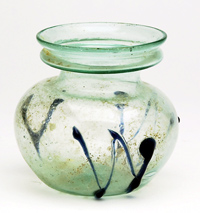 |
A Pristine Cosmetic Jar in Green and Dark Blue Glass. Roman, 3rd-4th century AD. The vessel in a light aqua-green glass and of very regular shape, and so perhaps mold blown. The body ovoid, with concave base, the wide funnel mouth folded to form a decorative, reinforcing ring beneath the rim. At three places along the side, dark blue glass has been applied in letter-like forms: W V W. Jar pristine and perfect! Height: 3". A very rare variant on a popular class of Late Empire vessels.
Estimated Value $2,000 - 2,500.
The normal form of trailed decoration on this group, and similar squat cosmetic jars is a regular, continuous zigzag, or a spiraling line. A handful are known where the trailed glass actually forms a word or inscription, and this is what seems to be intended on the above jar. For shape and treatment, cf. Newark, no. 178.
View details and enlarged photo
| Unsold |
Lot 724 |
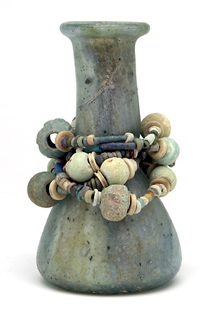 |
Ancient Roman Glass. Attractive Glass and Faience lot. Eastern Mediterranean and Egypt, c. 600 BC. - 600 AD. The first a well made and very robust unguentarium in a boldly colored, medium green to aqua glass: Roman, c. 1st-2nd century AD. The blown vessel with piriform body, cylindrical neck which is pinched in at base, and a flat rim with inward folded lip. Minor age crack on neck towards rim, which is typical for ancient glass which is this thick. Nevertheless, vessel is without a doubt stable and solid. Pleasing silvery to lilac iridescence on vial's interior. Along with this, a decorative necklace of collectible ancient beads of mostly Egyptian faience. The beads comprised of small tubes and discs, Late Period and earlier, in vivid turquoise, various blues and greens, along with a few whites and reds. Interspersed among these are 15 larger ovoid beads in blue or pale green faience, either Egyptian or ancient Persia. These flanked by thin, lathe-turned discs in bone: early Islamic. All nicely preserved. Glass bottle height: 4". Necklace length: 23". Pleasant lot of 2 items.
Estimated Value $250 - 350.
View details and enlarged photo
| Realized
$144 |
Lot 725 |
 |
Roman Discus Lamp with Facing Bust of a Satyr. Italy, c. 75-200 AD. A neat little lamp from Roman Italy. The lamp with circular body, fin-like handle which is grooved and pierced, and short, ovate nozzle. Within central discuss, in bold, rustic forms, the frontal bust of a youthful satyr brazenly gazes at the viewer. His hair wild and unkempt, with possible goat or fawn ears at the sides. Lamp sharply molded in tan-beige ware, with much of brown to dark red glaze intact. On the bottom, the maker's initials: C A M. Lamp complete, with signs of moderate use. Length: 4". An amusing and eye catching artifact.
Estimated Value $400 - 600.
View details and enlarged photo
| Unsold |
Lot 726 |
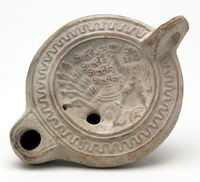 |
Fine Roman Discus Lamp with Cupid Riding Hippocamps. North Africa(?), c. 75-225 AD. Neatly crafted lamp like the previous type, in red-orange ware with whitish patina. Within the central discus, four hippocamps swim to the left. Grasping their reins in one hand, a plumpish, childlike figure (Cupid?), draped in a cloak, stands with one foot on the back of one. Bordering the discus, a wave/zigzag pattern. Lamp complete, with signs of very light use. Length: 4-7/8". An excellent and stylish example!
Estimated Value $400 - 600.
Cupid riding a (usually one) hippocamp is a motif acquired from the Greek world by the Romans, and one which proved to be exceptionally popular and enduring in their decorative arts. It, and variations, are found in such media as coins and gems, along with mosaics, silverware, wall paintings, and on up to marble sculpture.
View details and enlarged photo
| Unsold |
|
|